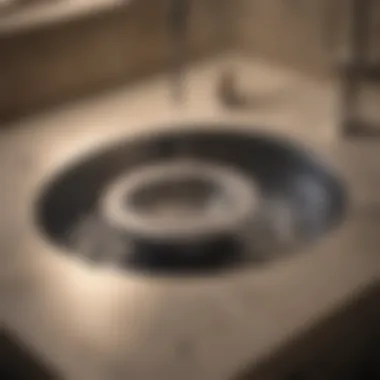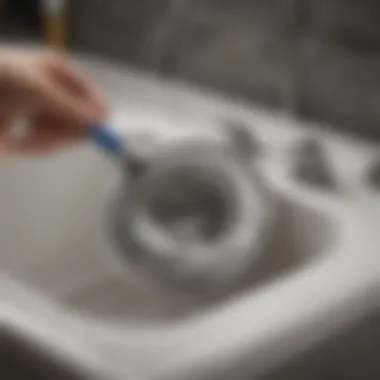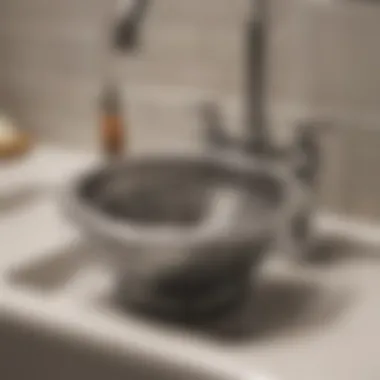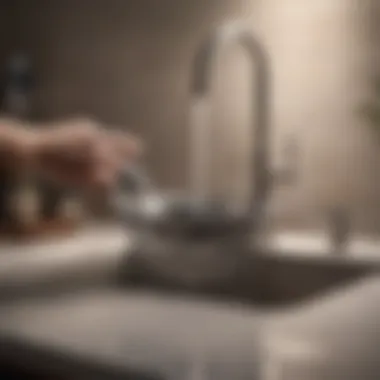Mastering the Art of Removing a Sink Strainer: A Complete Guide for Homeowners and DIY Enthusiasts


Interior Design Tips
Removing a sink strainer may not seem directly related to interior design, but a properly functioning sink is integral to any well-designed kitchen. The process of removing a sink strainer can be intimidating for many homeowners, but with the right tools and guidance, it can be a manageable task. This comprehensive guide aims to break down each step involved in removing a sink strainer, ensuring a smooth process for individuals looking to maintain their kitchen's functionality.
Let's start by highlighting some of the common tools required for this task. An adjustable wrench, pliers, and a screwdriver are essential items to have on hand. These tools will help in loosening connections and securing parts during the removal process. Once you have gathered your tools, it's important to turn off the water supply to the sink to avoid any potential leaks or accidents.
Moving on to the removal process itself, the first step involves locating the lock nut underneath the sink. This nut holds the strainer in place and needs to be loosened to release the strainer. Using an adjustable wrench, carefully rotate the lock nut counterclockwise until it is loose enough to be removed by hand. Be mindful of any attached pipes or connections that may also need to be detached.
As you proceed with detaching the lock nut, you may encounter some resistance due to corrosion or build-up. In such cases, applying a lubricant can help loosen the nut and facilitate easier removal. Once the lock nut is off, gently push up on the sink strainer from below to detach it from the sink. Inspect the surrounding area for any remaining debris or residue that may need to be cleaned before installing a new strainer.
Introduction
In the realm of household maintenance, the intricacies of sink strainers often go unnoticed until the inevitable moment when they demand attention. This comprehensive guide delves deep into the art of removing a sink strainer, shedding light on the imperative steps and tools essential for a seamless execution. Understanding the significance of this process is crucial, as a functional sink strainer is vital for maintaining a properly working kitchen or bathroom sink. By dissecting each component and elucidating its purpose, this guide empowers homeowners and DIY enthusiasts to navigate this task with confidence.
The journey of sink strainer removal commences with laying down a solid groundwork of comprehension on its anatomy and function. By deciphering the inner workings and relevance of a sink strainer, individuals can grasp the essence of why this process holds paramount importance in the domain of household maintenance and renovation. With an emphasis on preparation and meticulous attention to detail, this guide sets the stage for a transformative experience, revolutionizing the way individuals perceive and undertake the task of sink strainer removal.
Moreover, this guide offers a seamless transition into the practical realm by furnishing a detailed breakdown of the tools required for a successful undertaking. From wrenches to plumbers' putty, the emphasis on safety precautions and efficient tool usage underscores the commitment to a hassle-free experience. By nurturing a culture of preparedness and precision, individuals embarking on this journey equip themselves with the necessary arsenal to tackle any challenges that may arise along the way.
Diving further into the procedure, the step-by-step removal process elucidates the delicate intricacies of turning off the water supply, accessing the sink drain, loosening the locknut, and, finally, removing the old strainer. Each step is intricately laid out, complemented by detailed instructions and expert tips to ensure a smooth progression through the removal process. By encapsulating the essence of efficiency and effectiveness, this guide serves as a beacon of knowledge for individuals traversing the realms of sink strainer removal.
In essence, this comprehensive guide on the art of removing a sink strainer transforms a seemingly arduous task into a streamlined and empowering experience. By amalgamating practical insights, expert tips, and meticulous instructions, this guide caters to homeowners and DIY enthusiasts, serving as a cornerstone for anyone seeking proficiency in household maintenance and renovation.
Understanding the Sink Strainer


In the realm of sink maintenance and repair, understanding the sink strainer plays a vital role. This section will delve into the intricacies of this seemingly simple yet crucial component, providing insight into its anatomy, purpose, and importance. By grasping the fundamentals of the sink strainer, homeowners and DIY enthusiasts can enhance their overall understanding of sink systems and improve their ability to troubleshoot and maintain these fixtures effectively.
Anatomy of a Sink Strainer
The sink strainer, often overlooked in its significance, consists of several key elements that work harmoniously to prevent clogs and facilitate proper drainage. Comprising a strainer body, basket strainer, locknut, and rubber gasket, this mechanism serves as the first line of defense against debris entering the plumbing system. Understanding the role of each component is essential for successful removal and replacement procedures, ensuring the smooth operation of the sink.
Purpose and Importance
The purpose of a sink strainer transcends mere functionality; it is a guardian of your plumbing system. By capturing food particles, hair, and other debris, the sink strainer prevents blockages that could lead to costly repairs and water damage. Its role in maintaining proper drainage cannot be understated, making it a vital safeguard for the longevity of your plumbing infrastructure. Recognizing the importance of this component equips homeowners with the knowledge necessary to preserve the efficiency of their sinks and prevent potential issues down the line.
Preparation and Tools
In this segment of the comprehensive guide on removing a sink strainer, we delve into the pivotal aspect of preparation and tools, an indispensable phase before embarking on the task. Proper preparation sets the foundation for a successful strainer removal operation, ensuring efficiency and accuracy throughout the process. The significance of this topic cannot be overstated, as having the right tools and a well-thought-out plan can prevent unnecessary complications and streamline the overall procedure.
Gathering Necessary Tools
To execute the sink strainer removal effectively, it is imperative to gather the requisite tools beforehand. Essential tools include a wrench, pliers, plumber's putty, a screwdriver, and a bucket for collecting water drainage. Each tool plays a crucial role in different stages of the removal process, facilitating smooth operation and precise execution. Having the proper tools at your disposal not only makes the task more manageable but also reduces the risk of causing damage to the sink or surrounding areas.
Safety Precautions
When undertaking any plumbing task, including removing a sink strainer, prioritizing safety is paramount. Before commencing the removal process, ensure to turn off the water supply to the sink to avoid accidental leaks or flooding. Additionally, wearing protective gloves is advisable to prevent injuries and shield your hands from sharp edges or debris. Exercise caution when using tools to loosen components, and be mindful of any electrical connections near the sink area. By adhering to these safety precautions, you not only safeguard yourself but also promote a secure and smooth removal operation.
Step-by-Step Removal Process
When it comes to removing a sink strainer, the step-by-step process is crucial for a successful outcome. This section will delve into the detailed stages involved in dismantling the sink strainer effectively. By following each step meticulously, you can ensure a smooth and hassle-free experience.


Turning Off Water Supply
While embarking on the journey of removing a sink strainer, the foremost step is to turn off the water supply. This action is necessary to prevent any leakage or water damage during the removal process. By cutting off the water source, you create a safe environment to work in and avoid unnecessary mess.
Accessing the Sink Drain
Accessing the sink drain is the subsequent step in the removal process. To effectively remove the sink strainer, you need to reach the underlying drain mechanism. This involves clearing out the area beneath the sink, positioning yourself for easy access to the strainer components for seamless removal.
Loosening the Locknut
The locknut plays a pivotal role in securing the sink strainer in its position. Loosening this component is a critical step in disassembling the strainer. By delicately loosening the locknut using appropriate tools, you pave the way for the effortless removal of the old strainer without causing any damage to the surrounding fixtures.
Removing the Old Strainer
The final and most anticipated step in the removal process is extracting the old sink strainer. With proper preparation and execution of the preceding steps, removing the old strainer should be a straightforward task. Carefully take out the strainer from its position, ensuring no forceful maneuvers to maintain the integrity of the sink and surrounding plumbing.
Dealing with Challenges
Dealing with challenges is a crucial aspect when it comes to removing a sink strainer. In this comprehensive guide, we address various potential obstacles that individuals may encounter during this task. By highlighting common issues and providing effective solutions, we aim to equip homeowners and DIY enthusiasts with the knowledge and skills necessary to overcome any difficulties seamlessly. Understanding how to deal with challenges not only ensures a successful strainer removal but also enhances one's overall plumbing proficiency.
Rusting or Corrosion
Rusting or corrosion of sink strainer components can present a significant hurdle when attempting to remove them. The accumulation of rust or corrosion over time may cause parts to seize or become difficult to disassemble. In such cases, applying a penetrating oil or rust dissolver can help loosen the affected sections. Additionally, using appropriate tools and techniques, such as gently tapping with a hammer or utilizing a pipe wrench, can aid in breaking the rusted or corroded seal. It is essential to proceed with caution to avoid damaging the sink or surrounding fittings while addressing this challenge.


Stubborn Locknuts
Stubborn locknuts often pose a common challenge during sink strainer removal. These fasteners can become tightly secured over time, making them resistant to traditional removal methods. To tackle stubborn locknuts, heating the nut with a hairdryer or lubricating it with WD-40 can help loosen its grip. Employing adjustable wrenches or pliers with a firm grip and applying steady pressure in the opposite direction can assist in turning the locknut. Patience and persistence are key when dealing with stubborn locknuts, ensuring a gradual and controlled loosening process.
Sealant Residue
Residual sealant left behind after removing a sink strainer can complicate the installation of a new unit. Sealant residue may adhere stubbornly to the sink or drainage components, requiring thorough cleaning to ensure a proper seal in the future. Using a sealant remover or a gentle solvent can aid in breaking down the residue for easier removal. Carefully scraping off the remaining sealant with a plastic scraper or soft brush can help eliminate any traces effectively. Prior to installing a new strainer, ensuring that all sealant residue is thoroughly removed can prevent leaks and promote a secure and lasting seal.
After Removal Steps
In the realm of sink maintenance, the steps to be taken after removing a sink strainer are crucial for ensuring the overall functionality and longevity of your kitchen or bathroom sink. Once the strainer has been successfully extracted, it is essential to proceed with thorough inspection and follow-up actions to guarantee optimal performance. Neglecting the post-removal steps can lead to potential issues down the line, emphasizing the significance of this phase in the strainer removal process. By diligently executing the after removal steps, you contribute to the efficiency and health of your sink, promoting a smooth and trouble-free experience in the long run. Therefore, dedicating time and attention to this phase is vital in maintaining a well-functioning sink system.
Inspecting the Drain
After removing the old sink strainer, a critical task that follows is inspecting the drain area meticulously. This inspection serves as a proactive measure to identify any underlying issues or concerns that may have been concealed by the previous strainer. By carefully examining the drain, you can detect potential leaks, clogs, or damage that require immediate attention, preventing future complications and ensuring the proper functioning of your sink. Moreover, inspecting the drain allows you to assess the overall condition of the sink's internal components, enabling you to address any maintenance requirements promptly. This thorough examination of the drain is integral to maintaining a healthy plumbing system, enhancing the efficiency and durability of your sink setup.
Cleaning and Maintenance
Once the drain inspection is complete, the next crucial step in the post-removal process is cleaning and maintenance. Cleaning the sink area thoroughly helps eliminate any debris, residue, or buildup that could impede the flow of water and compromise the sanitation of your sink. Using appropriate cleaning agents and tools, such as gentle cleaners and brushes, ensures that the sink remains free from grime and odors, promoting a hygienic environment in your kitchen or bathroom. Additionally, performing regular maintenance tasks, such as tightening connections and checking for leaks, enhances the longevity of your sink system and prevents potential issues from arising. By incorporating effective cleaning and maintenance practices into your sink care routine, you uphold cleanliness standards and uphold the smooth operation of your sink for years to come.
Conclusion
The Conclusion section of this article serves as the summarizing segment of the guide, encapsulating the essence and significance of mastering the art of removing a sink strainer. Understanding the key takeaways showcased throughout this comprehensive guide is essential in empowering homeowners and DIY enthusiasts to tackle this task efficiently. By delving into the intricacies of sink strainers, preparing adequately with the necessary tools and safety precautions, following a meticulous step-by-step removal process, and addressing potential challenges that may arise, individuals can navigate this task with confidence and precision.
One crucial aspect highlighted in this article is the importance of thorough preparation and knowledge. By emphasizing the anatomy and purpose of a sink strainer, individuals gain a deeper understanding of the components involved and the role they play in the seamless functioning of a sink. Additionally, by discussing the tools required and safety precautions to be observed, this guide prioritizes the well-being of individuals engaging in this activity, ensuring a secure and efficient removal process.
Furthermore, the systematic breakdown of the removal process itself equips readers with a clear roadmap to follow when dismantling a sink strainer. From turning off the water supply to accessing the sink drain, loosening the locknut, and finally removing the old strainer, each step is meticulously detailed to eliminate any ambiguity and streamline the procedure. By offering insights into dealing with common challenges such as rusting, stubborn locknuts, and sealant residue, this guide anticipates and addresses potential hurdles, empowering individuals to overcome them with ease.
Upon successful removal of the sink strainer, the guidance doesn't end there. The After Removal Steps section underscores the importance of inspecting the drain post-removal and undertaking thorough cleaning and maintenance practices to ensure the longevity and efficiency of the sink system. This holistic approach to the removal process instills a sense of responsibility and attentiveness in individuals, motivating them to care for their sink's components effectively.
In essence, this Conclusion section not only brings together the fundamental aspects discussed throughout the guide but also emphasizes the transformative power of knowledge and preparation in executing tasks successfully. By internalizing the insights shared in this article, readers are poised to approach sink strainer removal with confidence, precision, and a deeper appreciation for the intricacies of plumbing maintenance.







